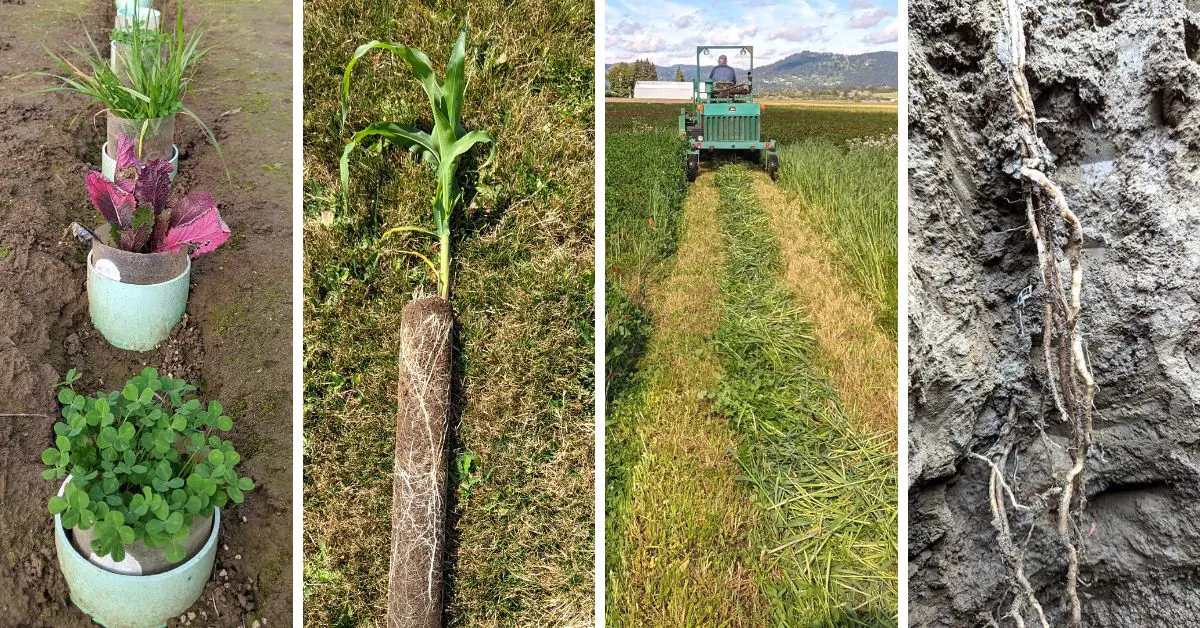Latest Research Updates
Roots Break Barriers

In the fall of 2021, we started a project we refer to as #RootsBreakBarriers. We assessed five cover crop treatments to determine which, if any, can fix either of two major soil challenges, compaction, or a zone of low pH. We created simulated soil profiles within clear sleeves placed into PVC tubes that were sunk in the ground to provide realistic weather conditions and soil insulation. One soil profile simulated a compacted soil with a bulk density layer of 1.6 g/cm3 which is considered root restrictive, another soil setting had layers with very low soil pH, to a minimum of 3.7. We used a control soil setting with no root restriction, and a plant control in each soil setting that had no cover crop.
At the end of May we cut the above ground biomass of each cover crop treatment to weigh and analyze the biomass. We then cut open 72 tubes into 6 soil horizons. We measured the compaction or pH that we achieved in each soil setting and cleaned the roots to weigh them for biomass.
Meanwhile, the remaining 216 tubes in the ground had corn planted into them. Our goal was to determine if a cash crop would do better following any of our cover crop treatments in either of the soil settings.
The most interesting result we found was that in the low pH soil setting all three cover crop treatments that included Lonestar Annual Ryegrass had a pH roughly 1 pH unit higher than the other treatments.
Even more exciting, the Lonestar treatments had higher corn biomass and ear mass than the other treatments.
This appears to be an unexplained phenomenon and we have now started two follow-up trials. For the follow up we will assess if this is a characteristic of Lonestar, or other annual ryegrasses, if this occurs with perennial ryegrass, or is a general characteristic of grasses. We will be testing these questions in the tubes and a field trial.
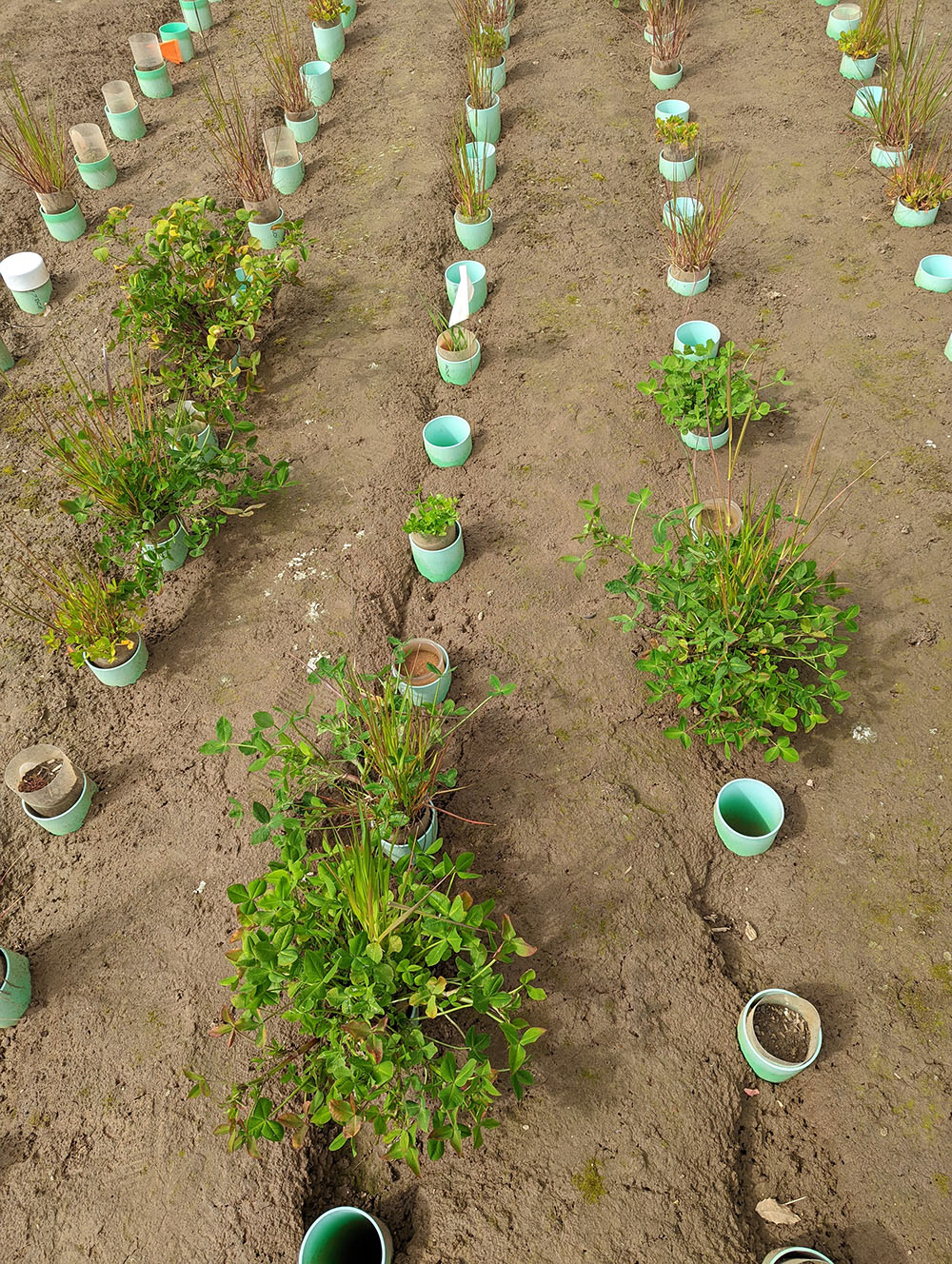
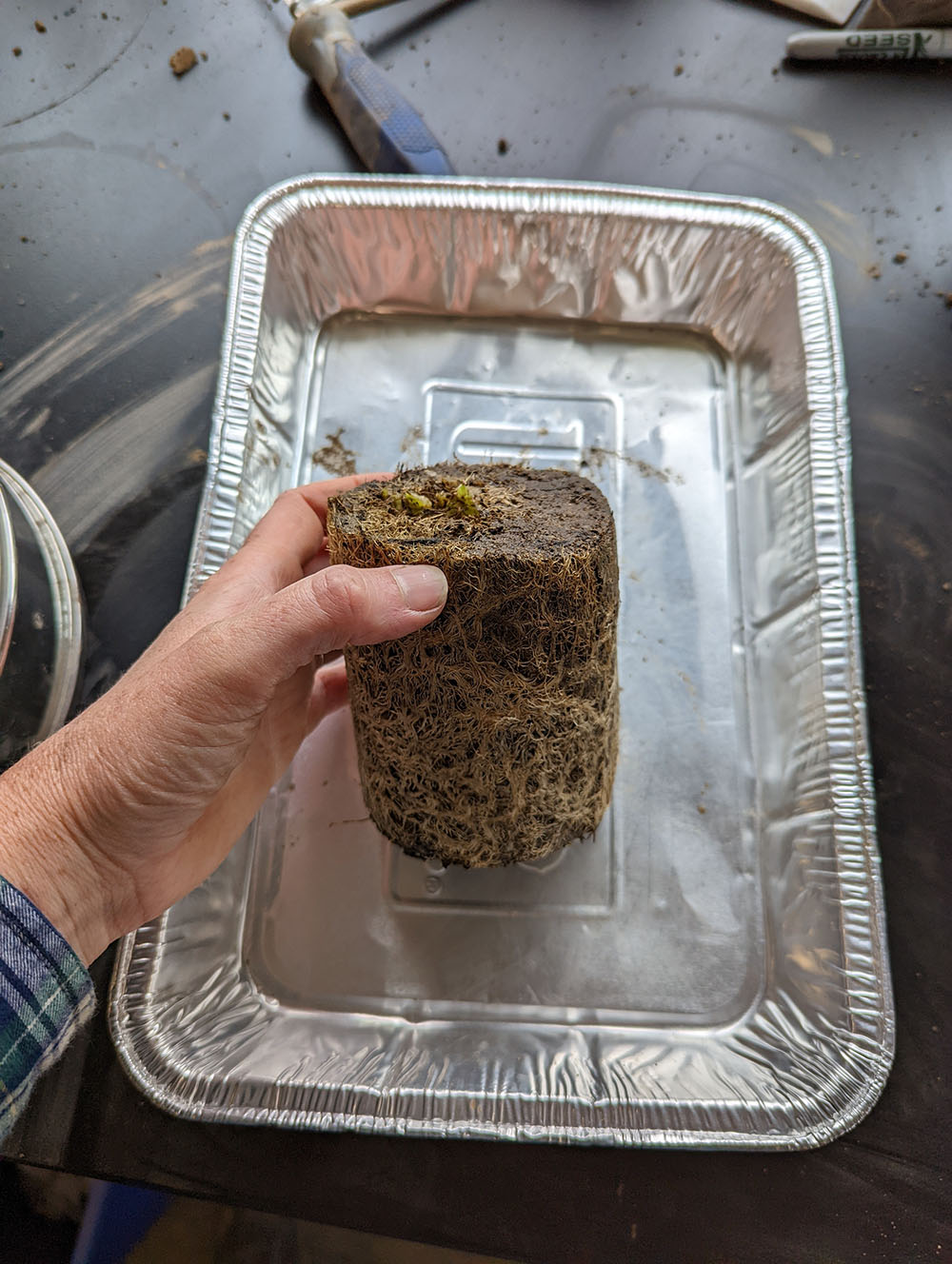

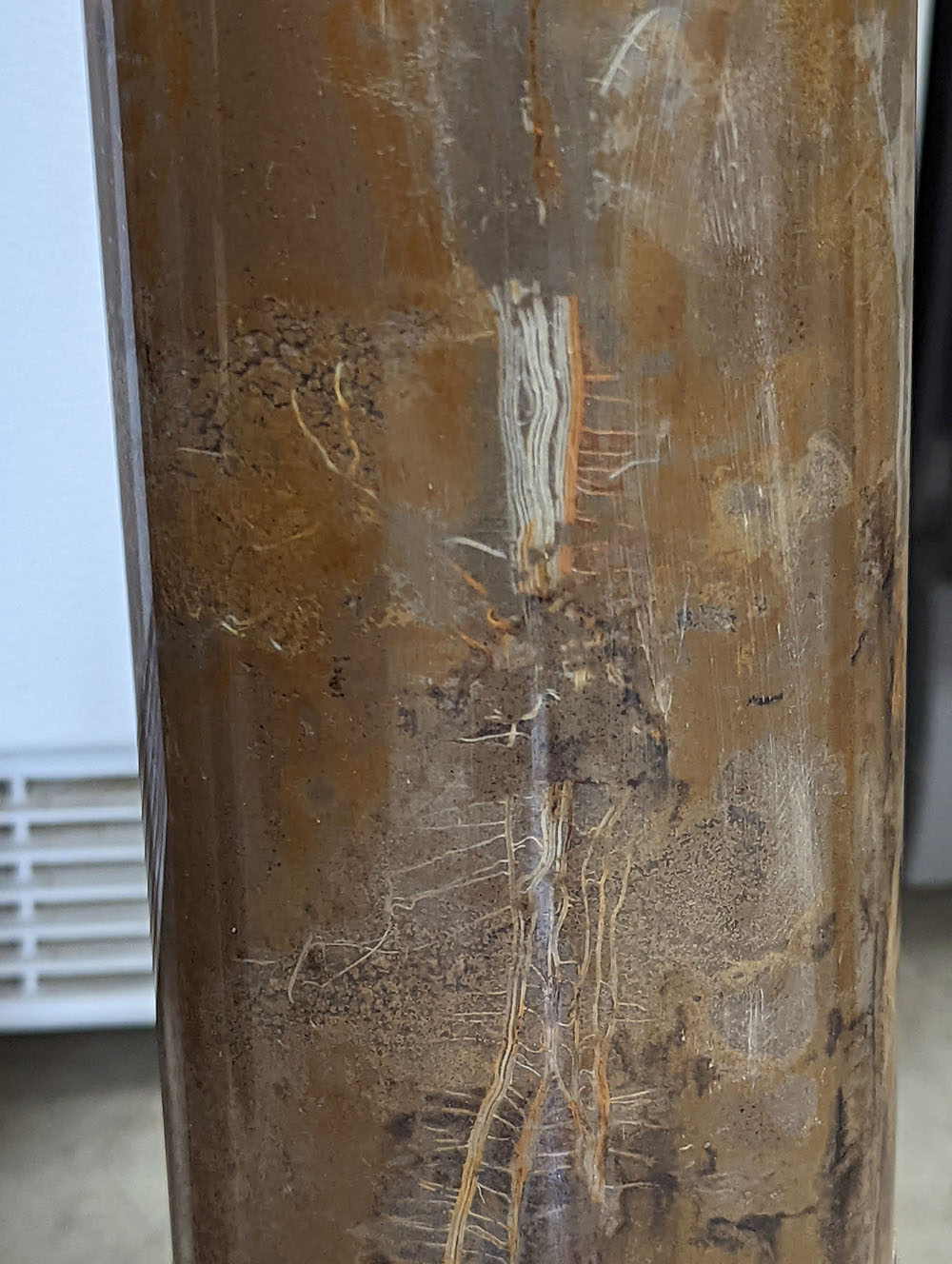
Root Visualization
The next research project in our “Tubes in the Ground” series is simply measuring the rate of root elongation, degree of branching, and root diameter. The unique apparatus of pvc tubes sunk into the ground allows us to pack specific soil profiles into clear plastic tubes that can experience realistic environmental conditions. We find that the roots follow a path along the inside of the tube wall, which makes it very easy to observe root growth. We seeded four replications of 21 varieties of plants into the tubes and have taken measurements once a week since planting. Initial planting took place on Sept 28rd, with replanting on Oct 10th for those that didn’t germinate the first time.

The first thing that popped out at me was the rapid elongation of all the brassicas we tested. Twelve days after planting, two of the replicates of the Driller Daikon radish were over 16 inches deep and two of our newest brassica variety, GO-TRT, were over 10 inches deep. At our measurement four weeks after planting, the GO-TRT was the first to reach the bottom of the tube which is a full 33 inches in depth. I was also impressed by the rapid growth and root diameter of the Survivor Winter Pea roots.
The most unexpected to me was the rapid growth and vigor of the Phacelia roots. At our next measurement date, we will include data on branching, root diameter, and the number of roots observed at depth.
Through this simple study we will be able to describe a process that is normally invisible. We are already making plans to use a similar set-up for breeding selections. When looking for plant vigor and stress tolerance, being able to visualize the roots is expected to give us a unique advantage.



FIXatioN Nitrogen Timing
A
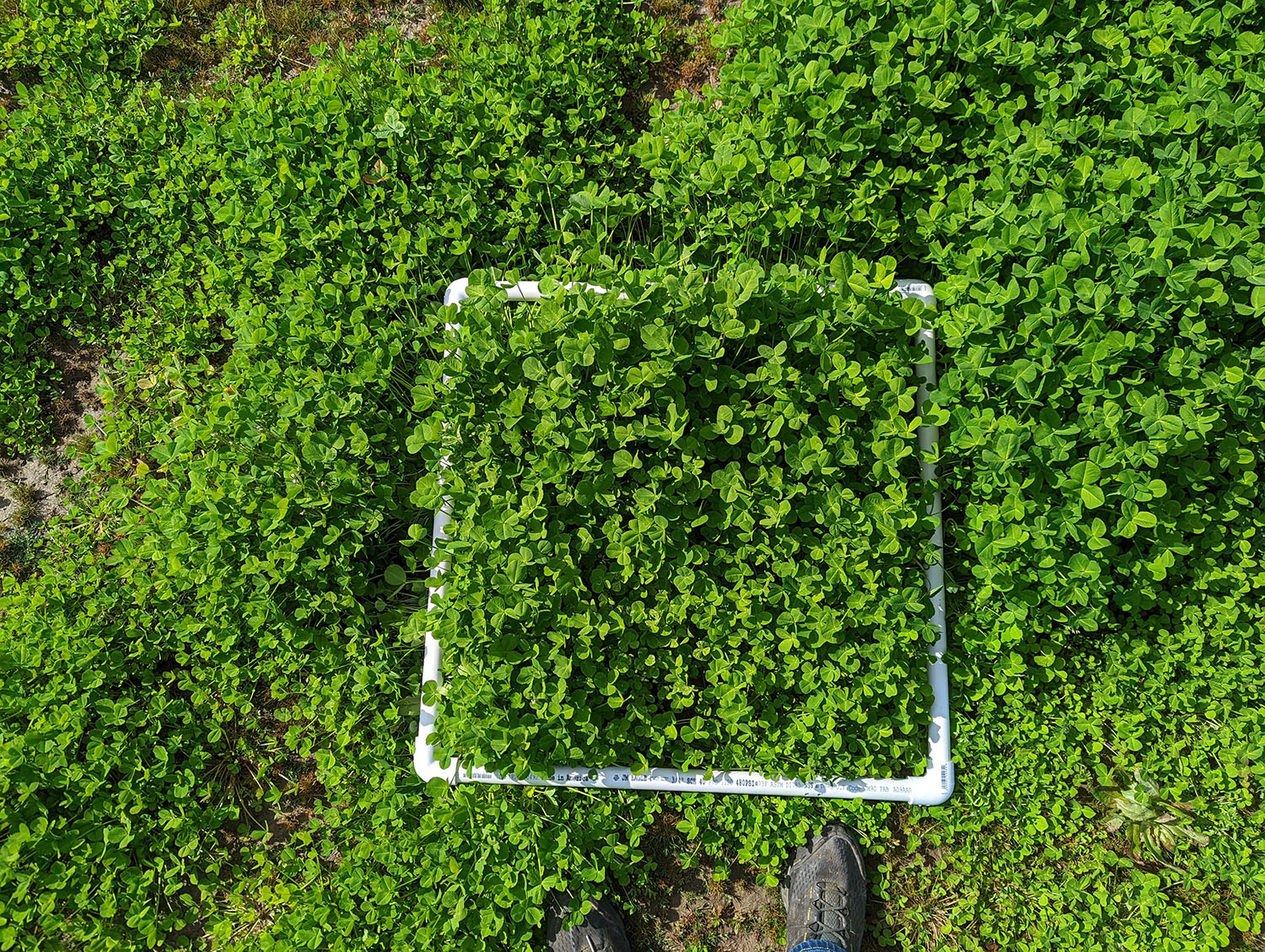
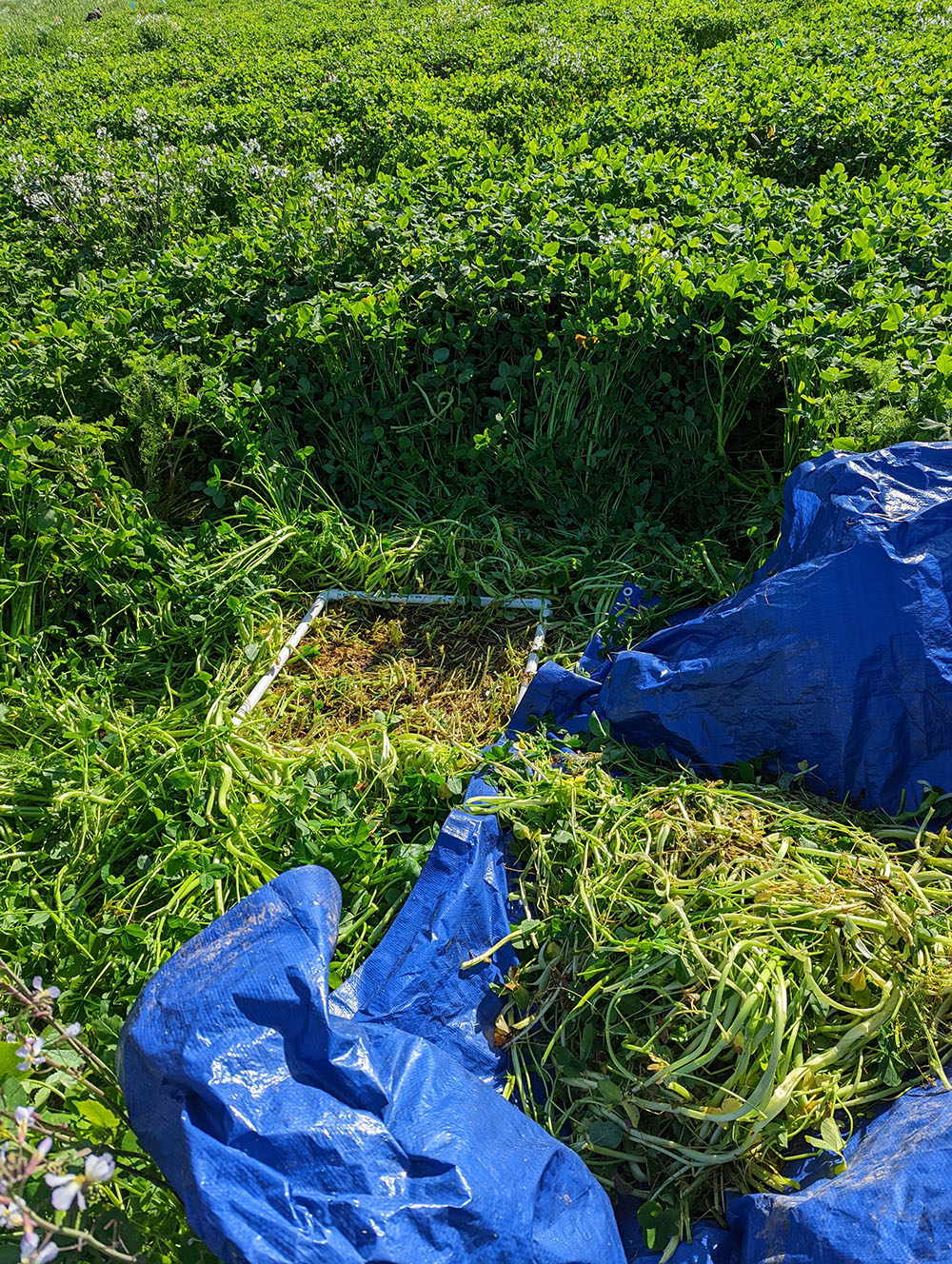
Spending money on cover crops can save money on the fertilizer bill. However, a farmer needs to know how much and when that nitrogen will become plant available before they take the risk of reduced fertilizer rates. Determining these answers is the primary goal of our #FixatioNNTiming project.
We assessed the quantity and timing of nitrogen availability from Fixation Balansa Clover. Similar, but smaller trials were also conducted at 5 other locations. In this trial we tested four different methods of termination: glyphosate, tillage, mowing and leaving the biomass, or mowing and removing the biomass. Each of those methods was used on May 11, May 24, and June 2.
The next research project in our “Tubes in the Ground” series is simply measuring the rate of root elongation, degree of branching, and root diameter. The unique apparatus of pvc tubes sunk into the ground allows us to pack specific soil profiles into clear plastic tubes that can experience realistic environmental conditions. We find that the roots follow a path along the inside of the tube wall, which makes it very easy to observe root growth. We seeded four replications of 21 varieties of plants into the tubes and have taken measurements once a week since planting. Initial planting took place on Sept 28rd, with replanting on Oct 10th for those that didn’t germinate the first time.
The first thing that popped out at me was the rapid elongation of all the brassicas we tested. Twelve days after planting, two of the replicates of the Driller Daikon radish were over 16 inches deep and two of our newest brassica variety, GO-TRT, were over 10 inches deep. At our measurement four weeks after planting, the GO-TRT was the first to reach the bottom of the tube which is a full 33 inches in depth. I was also impressed by the rapid growth and root diameter of the Survivor Winter Pea roots. The most unexpected to me was the rapid growth and vigor of the Phacelia roots. At our next measurement date, we will include data on branching, root diameter, and the number of roots observed at depth.
Through this simple study we will be able to describe a process that is normally invisible. We are already making plans to use a similar set-up for breeding selections. When looking for plant vigor and stress tolerance, being able to visualize the roots is expected to give us a unique advantage.

Partnering with the USDA-ARS we were able to use a LiCor machine to measure greenhouse gas emissions throughout the growing season. Early observations indicate that the plots without Fixation growing had higher nitrous oxide emissions. We eagerly await further analysis of this massive amount of GHG data.
It doesn’t matter how many times you hear it, until you grow it, you don’t realize how explosive the growth of Fixation is in the late Spring. At each termination time the total biomass and C:N ratio of Fixation was measured. From May 11th to June 2nd the biomass increased from an average of 29 inches to 61 inches tall and the dry mass went from 2.9 tons to 8.5 tons of dry biomass per acre.
Two weeks after planting the corn into all plots, we took soil samples and incubated them in the lab to measure how much N becomes plant available and how much work the microbes are doing. Preliminary analysis shows that the timing of the termination strongly influences the N availability, but the termination method does not. We will replicate this trial for another two years. Stay tuned.
Panels; A) Placing the square to take early biomass samples. B) Cutting the biomass from square and setting on tarp for weighing biomass. C) Shannon using LiCor to measure GHG in December. D) Termination by tillage. E) Goats enjoying removed biomass
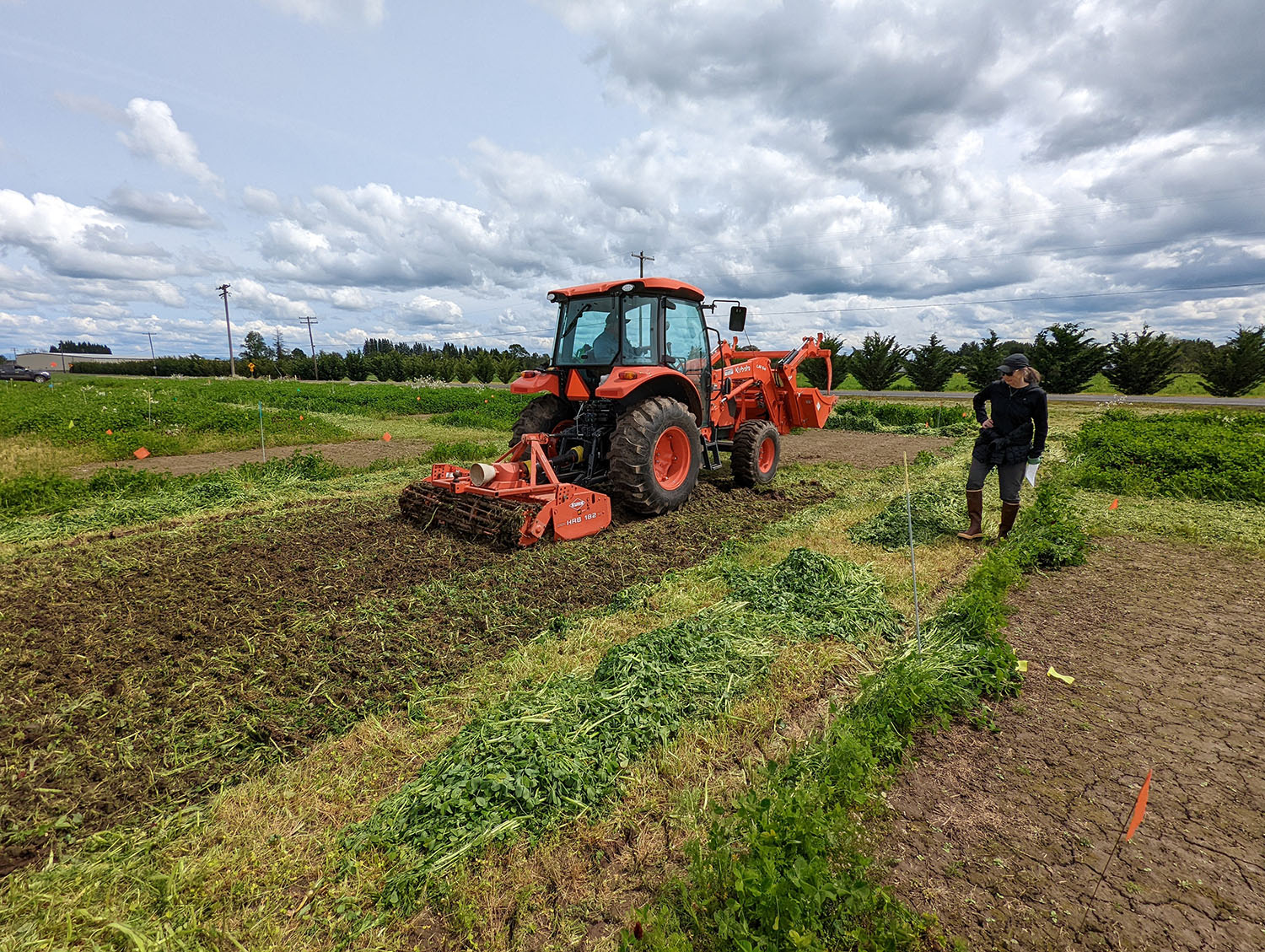
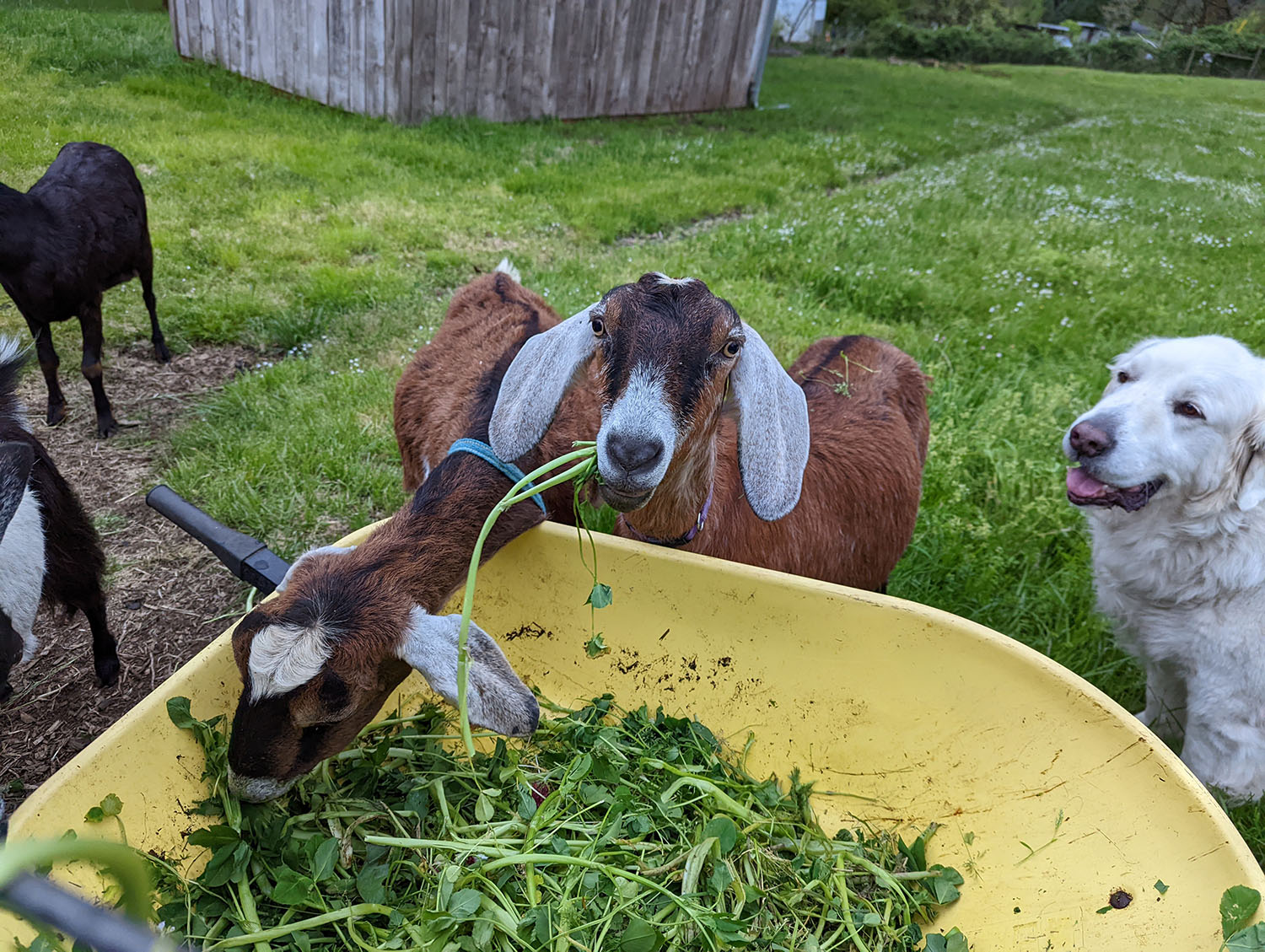
Perennial Falcata Alfalfa with Strip Tilled Corn
After several years of success with our experimental variety of upright falcata alfalfa, GO-FU, as a perennial cover crop, we expanded our testing. Starting in the fall of 2021 we have had ongoing trials in Michigan, South Dakota, Ohio, and Iowa. Each of these has a slightly different major focus but all are aimed at determining the best ways to use Falcata as a perennial cover crop.
In South Dakota the aim is to evaluate both the corn row spacing and the N requirement. What we learned after the first year is that young falcata will die from a full rate of Glyphosate when applied around April of its first year. This lesson was re-iterated with the results from the Ohio trial. They had a good stand established in the fall but chemical application too early in the season will knock it out altogether.


These trials have inspired follow-up trials focused on herbicide management. Starting the fall of 2022 we established trials in Richland, IA and Wooster, OH to determine the tolerance of GO-FU, Aberlasting, and Dynamite to glyphosate, glufosinate, and 2,4-D. We will assess efficacy at two different times, immediately prior to planting corn, and around v6. At each application time we will apply each herbicide on the low end of the recommended rate and at the high end of the recommended rate. We expect this to be a major tool to help guide producers on how to effectively establish and maintain each of these varieties as perennial cover crops.
The trial in Michigan is comparing GO-FU to sativa alfalfa as an intercropping system for dairy silage. The crop yield and feed quality will be evaluated along with nitrogen credits and impacts on soil health. The first round of harvest was just completed, so stay tuned for more data.
For the first time this year, the corn grown with the falcata was not as vigorous as the corn grown without falcata at our site in Richland, IA. It is expected that the cool spring had a strong impact on slowing the microbial activity required for N fixation. We also expect that planting the corn from north to south would be beneficial so that the falcata is not constantly shaded throughout the year.

Panels: A) Unfertilized corn showing week growth with vigorous falcata. B) Corn growth with falcata in foreground and fertilized, non-cover cropped control in back. C) Falcata remaining after corn removal. Portion to the left is after a full rate of glyphosate, right side is a half rate of glyphosate applied at v6
Perennial Groundcover Project with Iowa State
A team at Iowa State, led by Dr. Kenneth Moore, has been working on Perennial Groundcover projects for many years to transform row crop erosion problems. This kind of industry leading creative thinking is exactly what we are after when we talk about finding plant-based solutions to production challenges. After several years of mixed results with a very aggressive bluegrass cultivar, Jerry pointed out that the variety matters and recommended Milagro because it is more compact, has a short rhizome which leads to lower spread, and has always had good shade tolerance.
The team was delighted by the results using Milagro and we were asked to participate in a 5 year, 10-million-dollar project called, “Perennial Groundcover: A Scalable Systems Approach to Achieving Soil & Water Conservation with High-Yield, Row Crop Production in Iowa.” The general idea is to plant rows of Milagro in real production fields in 5-acre plots and strip till the cash crop into the rows to enhance photosynthetic capture, send more carbon into the soil, and minimize soil erosion.
Ten farmers are enrolled in the project, six participants successfully seeded groundcover in the spring of 2022, with two sites needing re-seeding and two remaining sites scheduled for spring 2023 seeding. Interest in the project is incredible, with 60 farmers attending the recent fall field day in northeastern Iowa. Baseline soils in the spring and fall and whole plant samples of the main crop (corn or soybean) at V8, R1, R6 were taken to measure biomass and nitrogen content. Corteva also imaged the grass at planting, V8, R1, R6 to estimate ground cover and understand weed suppression. Visit https://www.abe.iastate.edu/pgc-team/ to learn more.
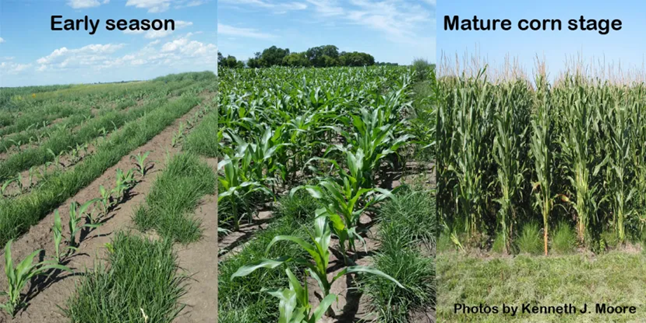
Carbon Sequestration – Value added Pasture Potentials
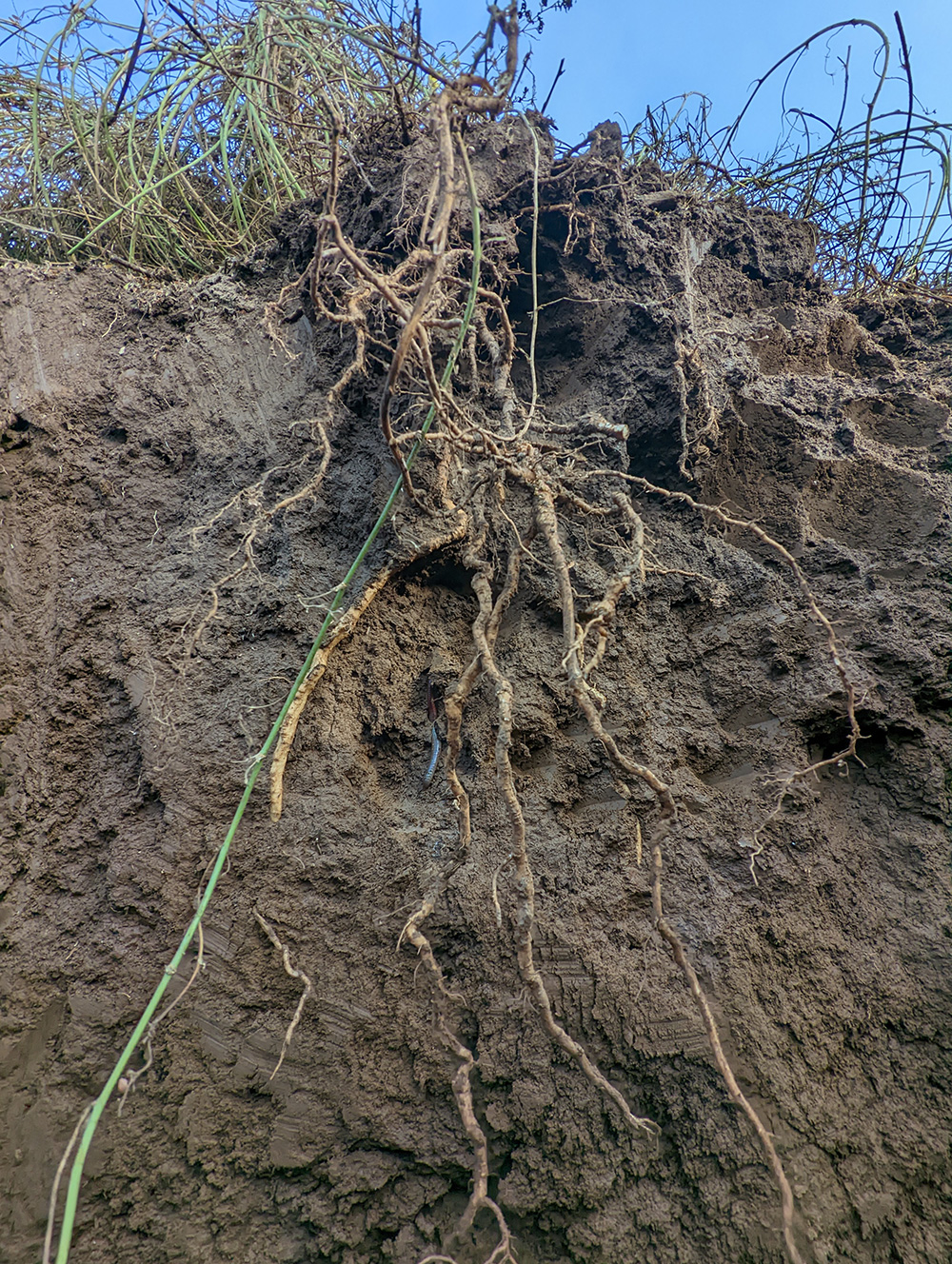

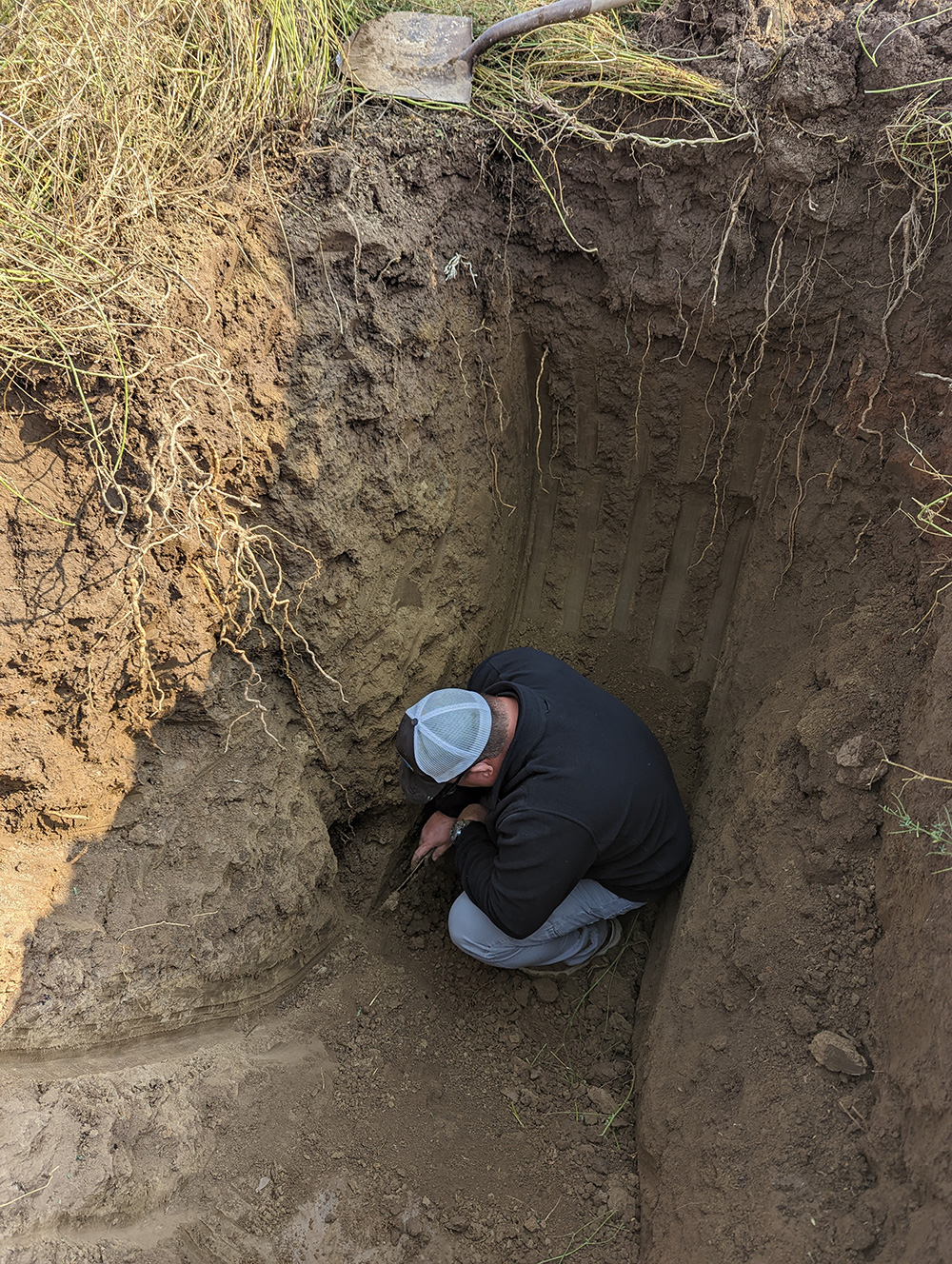
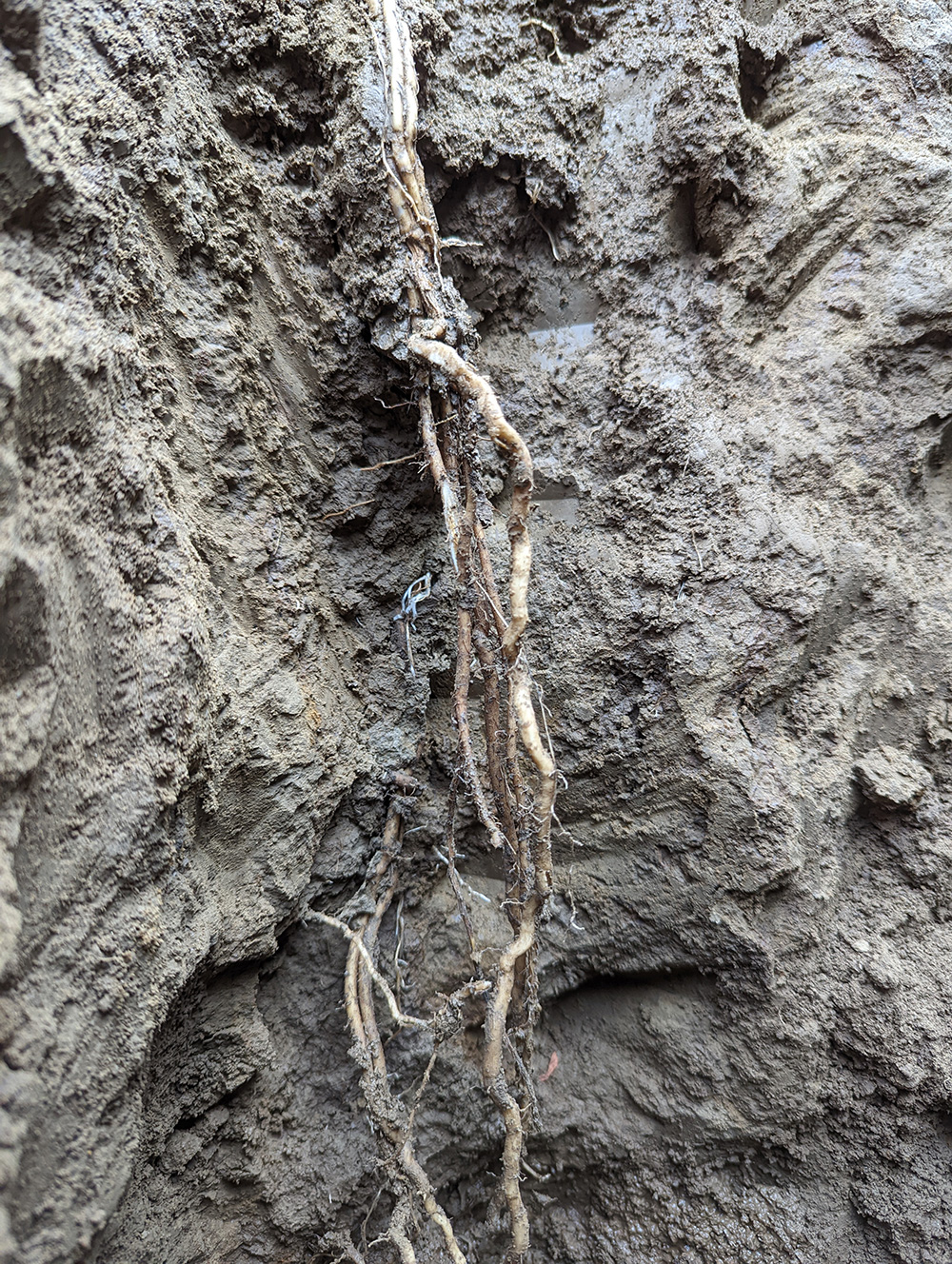
The carbon markets have the potential to transform agriculture as we know it and we are actively accounting for this potential in the development of new varieties of turf, forage, and cover crops.
After a typical Oregon summer with minimal rain, several people commented on how green the unirrigated field of falcata was on our research farm. We decided to dig a soil pit and see how deep the roots are. So far, we have dug over two meters deep, the roots are still almost a pencil thick and we have not found the bottom yet.

